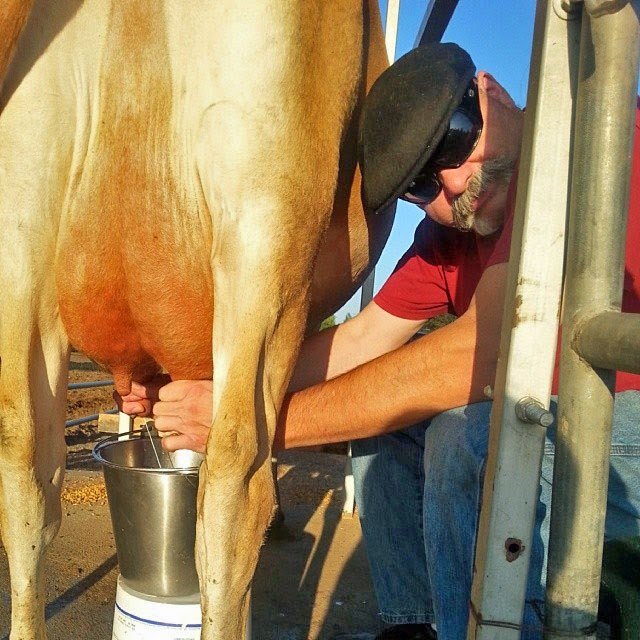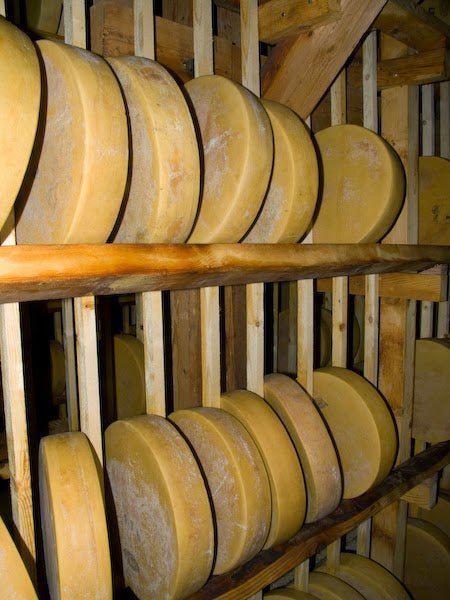 |
| Emma Reeves |
Emma Reeves (12) in Orem, Utah is already knowledgeable about the role milk plays in the quality of cheese. For her science project this year, she compared 5 different kinds of milk to see how they performed when making both hard cheese and Mozzarella (see the entire project at the end of this post).
Emma’s mother, Lisa, helped her ask Jim Wallace, our technical advisor, a few questions about her project.
Jim loves to get inquiries from young people. Here are Emma’s questions and his answers:
My name is Emma Reeves and I am a 6th grader in Utah. I am doing a science experiment comparing 5 types of milk, because I want to figure out which is the healthiest to drink. I am using raw cow’s milk, pasteurized, ultra-pasteurized, powdered and canned. For the first part of my experiment, I put each type of milk in a jar and left it at room temperature for 1 week.
 |
| The 5 different kinds of milk Emma used |
Emma, it is good to see such a young person take an interest in the food
you eat and how it is processed. We would certainly be a healthier
nation if more people did this. Hopefully, you sanitized the jars before transferring the milk, since ambient bacteria, etc. would skew the results.
The next part of my experiment was making basic hard cheese with each
type of milk. I hope you won’t be bothered by my e-mail, but I have a
few questions I hope you can answer.
I love answering questions from curious minds. The only problematic questions are those not asked.
1. First, the ultra-pasteurized milk and canned milk never formed curds, so I was not able to make cheese with them.
This would be expected since the very high process temperature of pasteurization and cooking the milk for canning would have destroyed most all bacteria.
This heating process also changes the protein structure so that even when culture is added, it will not form a curd for cheese making.
2. That did not surprise me, but I was very surprised that I was able to make cheese with powdered milk. It seems like powdered milk would be the most processed and most difficult to make cheese with of all the types I experimented with.
Can you give me any idea of why the powdered milk worked and the canned and ultra-pasteurized did not?
The powdered milk is actually treated pretty well during processing. Much of what we see is a low temperature and spray dried process that leaves the proteins in good shape for cheese making. In some of our recipes, online and in our book (Home Cheese Making) we offer info on making cheese from non-fat dry milk powder and cream.
 |
| Testing for the clean break |
3. I did find it interesting to observe that of the 5 milk types that I set out at room temperature for 1 week, the ultra-pasteurized, canned and powdered seem the same as when I put them in the jar – they don’t stink or anything.
These three are essentially all dead milks. The bacteria in the first two have been taken out mostly with heat, but the powdered milk undergoes a moderate amount of heat and the bacteria is largely inactivated by drying. This is why they can be stored on store shelves for so long.
 |
| Hard cheese curds |
4. The raw milk has thickened and separated and it smells stronger, but not rotten. The pasteurized is almost all a clear-ish liquid with a chunk of very firm curd on the very top. It does not smell good at all.
Here is a case of good and bad bacteria:
The raw milk has a
natural load of good bacteria (the kind that have been selected for
making cheese). It has undergone a natural fermentation and smells good
like cheese and would probably have tasted good as well. These bacteria
formed a more homogeneous curd, it seems. In times past, they called this
‘clabbered milk.’
The pasteurized milk had all of it’s good bacteria taken out during
processing. Any bacteria that were working then, were bacteria that were
ambient bacteria (not good dairy bacteria) still in the milk and not
destroyed during pasteurization (pasteurized milk is not sterile milk).
These are not necessarily good ones and anything that is not killed
during pasteurization will grow at room temperature. This is why normally
pasteurized milk goes ‘bad.’ This description indicates an over-acid
mix of curd and separated whey.
5. Could you give me any idea why the 5 types of milk reacted the way they did after 1 week at room temperature? I am not sure if I would want to eat the raw milk and I would never want to eat the pasteurized one, but what about the other three?
You would be wise not to try the raw milk unless you knew more about its character and healthy condition. If you could determine that it was safe, then it would be the most healthy milk. BUT, raw milk can also contain some pretty dangerous bacteria as well. Common sense and a little background searching should sort out the good from the bad (most folks selling raw milk are required to have it tested for bad bacteria).
 |
| Raw milk Mozzarella |
6. They don’t seem like they have changed at all after a week. Is that a good thing? Or does it mean they are dead and, because of that, they don’t change?
A good thing?? only in that the seller can keep them on the shelf longer and not pay attention to them. A bad thing in that they are dead milk and some of their enzymes and nutrients are no longer useable for your body.
7. If that is true, why would powdered milk make hard cheese?
See my 2nd response above.
I hope this helps and I would give you an A+ on your project for the planning, observations and followup questions. (I was a science teacher in a former life.)
We asked Lisa to tell us about her daughter:
“Emma is very inquisitive. She is always asking questions. She is a
kind, sweet girl. She loves all sports and is very involved in soccer and
track. She also likes to snow ski and water ski. She does some
rappelling and loves to go boating with her family. Emma also plays the
cello.”
This past summer Emma and her family spent the summer in Europe: mostly in Italy and France but also England, Switzerland, and Netherlands.
Emma’s Science Project
GOT MILK?
Out of 5 Types of Milk, Which is Best for Making Cheese?
Introduction:
I wanted to do this experiment because I wondered what kind of milk would make better cheese and that might help me understand milk and which kind is healthiest for me.
Hypothesis
I think Raw Milk will work best, then Pasteurized, then Ultra-Pasteurized, then Evaporated, and last Powdered.
Types of Milk Used:
Organic Whole Raw Cow’s Milk
Pasteurized Whole Homogenized Cow’s Milk
Organic Ultra-Pasteurized Whole Homogenized Cow’s Milk
Evaporated Cow’s Milk
Non-Fat Pasteurized Powdered Cow’s Milk
Hard Cheese Making Experiment
Raw Milk: Formed a good curd and was easy to cut into cubes.
Weight: 1.2 lbs
Appearance: More creamy looking.
Powdered: The surface looked bubbly. It had firm curds so it was easy to drain the whey. The curds were about the same as the raw milk curds.
Weight: 1.1 lbs
Appearance: More yellow looking.
It didn’t make sense to me that the powdered milk worked so well. I thought it would be the most processed, so I wrote a scientist and cheese maker and this is what he said, “Powdered milk is actually treated pretty well during processing. Much of what we see is a low temperature and spray dried process that leaves the proteins in good shape for cheese making.”
Pasteurized: The curd was really soft and in smaller curds after cutting. Even though I let it sit longer it was still hard to cut because it was so soft. It was harder to drain the whey off, so when I put the cheese curds in the press it was more full because there was still a lot of whey in the curds.
Weight: .14 oz
Appearance: A little more greyish looking.
Ultra-Pasteurized: It did not form curds. I let it sit for half a day and it finally formed a clean break so I could cut it into cubes, but when I started heating the curds they just dissolved and it was just thickened milk about as thick as gravy.
Weight: 0 (Would not form curds so I was not able to make cheese)
Evaporated Milk: It did not form curds. I let it sit for half a day and it finally formed a clean break so I could cut it into cubes, but when I started heating the curds they just dissolved and it was just thickened milk about as thick as gravy.
Weight: 0 (Would not form curds so I was not able to make cheese)
Mozzarella Cheese Experiment
Raw: It formed a firm curd and I was able to cut into cubes. It was really stretchy and made a nice ball of mozzarella.
Powdered: It formed a thick curd that I could cut into cubes. When I stretched it, it was not as smooth as raw. It was stringy and it got shiny like when you pull taffy. It formed a ball of mozzarella. It didn’t make sense to me that the powdered milk worked so well. I thought it would be the most processed, so I wrote a scientist and cheese maker and this is what he said, “Powdered milk is actually treated pretty well during processing. Much of what we see is a low temperature and spray dried process that leaves the proteins in good shape for cheese making.”
Pasteurized: It didn’t form a thick curd. It was more like cottage cheese and I was not able to cut the curd into cubes. It was hard to drain the whey off because the curd was so small. I had to drain the curds for a couple hours. When I tried to stretch it, it was impossible because it was liquid like pancake batter and didn’t hold together. I read that you need to be careful what pasteurized milk you use, because many brands of pasteurized milk are heating their milk to a higher temperature closer to the Ultra-pasteurized temperatures and that milk will not work for mozzarella. If you use pasteurized milk for mozzarella you need to make sure it is a brand that heats milk in a lower temperature.
Ultra-Pasteurized: It formed a better curd than pasteurized milk. I was able to cut it in curds, but then when I heated it, it turned more like cottage cheese. It didn’t stretch at all.
Evaporated: It didn’t thicken or form a curd at all. If it sits for about half a day it will form a clean break and it can be cut, but then it dissolves when heated, so there is no way that you can stretch it.
Conclusion
Raw milk was the easiest to make hard cheese and mozzarella. Powdered milk was the next easiest, then pasteurized, then Ultra-Pasteurized and Evaporated.
As far as taste, the raw milk was voted the best by 6 different taste testers on both hard and mozzarella, then powdered, and then pasteurized. Ultra-Pasteurized and Evaporated did not work for either hard cheese or mozzarella.
Emma’s Data
Hard Cheese Blind Taste Test
#1 Raw Milk Hard Cheese
Tester #1
Taste: Best Tasting
Texture: Best Texture
Smell: Buttermilk smell
Favorite one overall
Tester #2 (Four Year Old)
Like this one
Favorite one overall
Tester #3
Taste: Very Mild/bland
Texture: Rubbery
Smell: Paint
Favorite one overall
Tester #4
Taste: Mild Cheese
Texture: Normal Cheese
Smell: Buttermilk
Favorite one overall
Tester #5
Taste: Very Mild Cheese
Texture: Soft
Smell: Nothing
Favorite one overall
Tester #6
Taste: Soft and less squeaky. Not as sour as powdered. Better flavor than powdered*
Texture: Feels a little soft and flexible on outside. Soft and smooth when bite into it.
Smell: Smells a little like buttermilk.
Favorite one overall
#2 Pasteurized Milk Hard Cheese
Tester #1
Taste: Mild, like dry tofu
Texture: Most rubbery and dry
Tester #2 (Four Year Old)
Doesn’t like this one
Tester #3
Taste: Gross- spit it out!
Texture: Hard
Smell: Paint
Tester #4
Taste: Nothing
Texture: Like an eraser
Smell: Buttermilk
Tester #5
Taste: No taste
Texture: Awful, not like cheese! Too firm and dry. Yuck!
Smell: Nothing
Tester #6
Taste: Sweet and sour. I don’t like the flavor at all.
Texture: Hardest and driest on outside. More hard and dry when bite into it.
Smell: Smells like a doctor’s office and also smells like buttermilk. It doesn’t have a strong smell, but it is stronger than the others.
#3 Powdered Milk Hard Cheese
Tester #1
Taste: Mild
Texture: Firm, kind of like rubber
Smell: Mild buttermilk smell
Tester #2 (Four Year Old)
Tastes like cheese
Tester #3
Taste: Bland
Texture: Rubbery
Smell: Rotten milk
Tester #4
Taste: Nothing
Texture: Rubbery
Smell: Buttermilk
Tester #5
Taste: A little sour
Texture: Squeaky
Smell: Like cheese
Tester #6
Taste: A tiny bit sour. Squeaky texture. When I suck on it, liquid comes out.
Texture: Feels a little soft and flexible on outside. Has a gross milk aftertaste like cows. Soft and smooth when bite into it.
Smell: Smells a little sour, but very mild.
Mozzarella Cheese Blind Taste Test
1a Raw Milk Mozzarella
Tester #1
Taste: Cheese
Texture: Mild
Smell: Nothing
Favorite
Tester #2
Taste: Mild
Texture: Normal Cheese
Smell: None
Favorite
Tester #3
Taste: Mild
Texture: Good, soft
Smell: None
Favorite
Tester #4
Taste: Nothing
Texture: Like fish flesh
Smell: Nothing
Favorite
Tester #5
Taste: Like Mozzarella
Texture: Soft
Smell: None
Favorite
Tester #6
Taste: Not much taste
Texture: Rubbery
Smell: Nothing
Favorite
2 a Powdered Milk Mozzarella
Tester #1
Taste: Nothing
Texture: Rubbery
Smell: Fish
Tester #2
Taste: Tofu
Texture: Rubbery
Smell: Glue
Tester #3
Taste: None
Texture: Weird, too firm/dry
Smell: None
Tester #4
Taste: None
Texture: Hard
Smell: Faint Cheese
Tester #5
Taste: Don’t Like
Texture: Hard
Smell: Milk
Tester #6
Taste: Nothing
Texture: More hard than 1A
Smell: Nothing

























































































































































